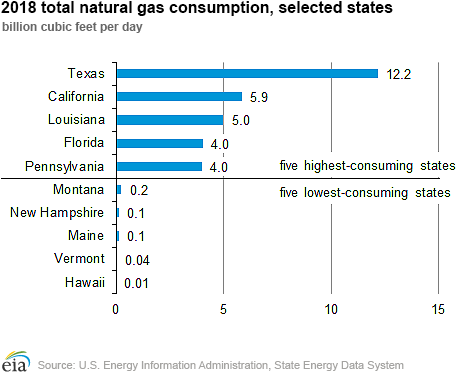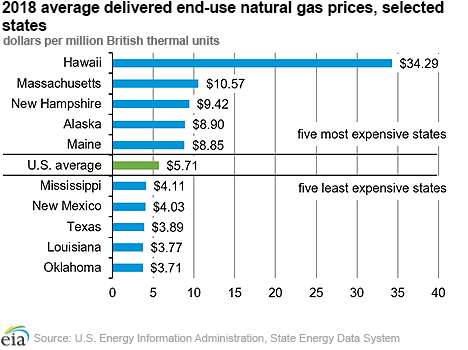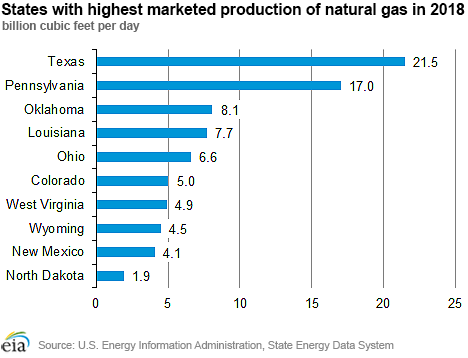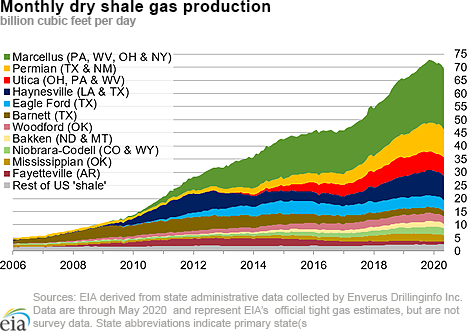In the News:
EIA’s updated State Energy Data System shows which states had the most consumption and production in 2018
EIA updated its State Energy Data System (SEDS) on June 26 with data for 2018. SEDS provides comprehensive energy information, including the consumption, production, and price of natural gas, for all 50 states and the District of Columbia.
Texas had the highest level of natural gas consumption in 2018 at 12.2 billion cubic feet per day (Bcf/d). The industrial sector is the largest consuming sector in Texas. The state has a significant amount of oil and natural gas extraction and processing that uses natural gas as fuel and a large chemicals industry that uses natural gas for heat, power, and feedstock. Texas also has the second-largest population of any state, contributing to its demand for power generation—42% of which was natural gas-fired in 2018—to meet cooling demand. The other high-consuming states also tend to have large populations (for example, California, Florida, and Pennsylvania) and/or high concentrations of natural gas-intensive industries (for example, Louisiana, California, and Pennsylvania).
Hawaii used the least amount of natural gas of any state in 2018 at 9 million cubic feet per day (MMcf/d). The sources of supply for Hawaii’s natural gas are synthetic natural gas (SNG) created from naphtha, imported liquefied natural gas (LNG), and renewable natural gas (RNG) produced locally from biomass. These sources are expensive, leading Hawaii to have the highest average natural gas price in the nation in 2018.
Hawaii’s average delivered end-use natural gas price was $34.29 per million British thermal unit (MMBtu) in 2018, compared with the national average of $5.71/MMBtu. Aside from Hawaii, natural gas in 2018 was most expensive in Alaska and states in New England where infrastructure constraints can lead to wholesale natural gas price spikes in periods of peak demand during the winter months. Natural gas prices were cheapest in regions close to the Permian Basin, which is in West Texas and Southeast New Mexico, and offshore Gulf of Mexico production (Louisiana and Mississippi). The state with the cheapest natural gas was Oklahoma, where the price averaged $3.71/MMBtu.
Marketed natural gas was produced in 33 states in 2018. Texas had the highest level of marketed natural gas production at 21.5 Bcf/d, followed by Pennsylvania with 17.0 Bcf/d. Much of Texas’s natural gas is associated natural gas that comes from crude oil-focused production. In Pennsylvania, most natural gas production is from wells focused on producing natural gas and hydrocarbon gas liquids.
SEDS contains more information on natural gas production, consumption, prices, and expenditures, as well as detailed data on other energy sources and sectors. In addition, EIA’s State Energy Portal, now published on EIA’s website in a beta version, integrates information from EIA's State Energy Profiles and other existing products.
Overview:
(For the week ending Wednesday, July 8, 2020)
- Natural gas spot prices rose at most locations this report week (Wednesday, July 1, to Wednesday, July 8). The Henry Hub spot price rose from $1.60 per million British thermal units (MMBtu) last Wednesday to $1.79/MMBtu yesterday.
- At the New York Mercantile Exchange (Nymex), the price of the August 2020 contract increased 15¢, from $1.671/MMBtu last Wednesday to $1.824/MMBtu yesterday. The price of the 12-month strip averaging August 2020 through July 2021 futures contracts climbed 5¢/MMBtu to $2.445/MMBtu.
- The net injections to working gas totaled 56 billion cubic feet (Bcf) for the week ending July 3. Working natural gas stocks totaled 3,133 Bcf, which is 28% more than the year-ago level and 17% more than the five-year (2015–19) average for this week.
- The natural gas plant liquids composite price at Mont Belvieu, Texas, rose by 52¢/MMBtu, averaging $4.55/MMBtu for the week ending July 8. The price of natural gasoline rose 90% as logistical constraints were alleviated, allowing natural gasoline prices to return to trend after being discounted in May and June when storage capacity at a major HGL storage terminal was constrained. Ethane, butane, isobutane, and propane rose by 10%, 8%, 6%, and 1%, respectively.
- According to Baker Hughes, for the week ending Tuesday, June 30, the natural gas rig count increased by 1 to 76. The number of oil-directed rigs fell by 3 to 185. The total rig count decreased by 2, and it now stands at 263.
Prices/Supply/Demand:
Prices rise at most locations with high temperatures. This report week (Wednesday, July 1, to Wednesday, July 8), the Henry Hub spot price rose 19¢ from $1.60/MMBtu last Wednesday to a high of $1.79/MMBtu yesterday, the highest spot price since late May. Temperatures were warmer-than-normal across the Northeast and Midwest. At the Chicago Citygate, the price increased 27¢ from $1.55/MMBtu last Wednesday to $1.82/MMBtu yesterday.
California prices end week at highs. The price at SoCal Citygate in Southern California increased 50¢ from $1.51/MMBtu last Wednesday to a high of $2.01/MMBtu yesterday amid warmer-than-normal weather in the Los Angeles area. The price at PG&E Citygate in Northern California rose 50¢, up from $2.15/MMBtu last Wednesday to a high of $2.65/MMBtu yesterday.
Columbia Gas Transmission (CGT) declares force majeure on Mountaineer Xpress pipeline (MXP). On Monday, CGT declared a force majeure at the Mount Olive compressor station, 40 miles north of Charleston, West Virginia. According to data from IHS Markit, U.S. natural gas production fell by 1.5 Bcf on Monday, as capacity was reduced on Mountaineer Xpress pipeline to 0.1 Bcf at the constraint point. MXP had a design capacity of 2.7 Bcf, and moves natural gas from Northeast production areas. Flows began increasing again today, but they are expected to be limited through July 13.
Northeast prices are up with high temperatures in the region. At the Algonquin Citygate, which serves Boston-area consumers, the price went up 19¢ from $1.53/MMBtu last Wednesday to $1.72/MMBtu yesterday. At the Transcontinental Pipeline Zone 6 trading point for New York City, the price increased 31¢ from $1.46/MMBtu last Wednesday to a high of $1.77/MMBtu yesterday.
The Tennessee Zone 4 Marcellus spot price increased 12¢ from $1.28/MMBtu last Wednesday to $1.40/MMBtu yesterday. The price at Dominion South in southwest Pennsylvania rose 3¢ from $1.32/MMBtu last Wednesday to $1.35/MMBtu yesterday. The price at Dominion South faced downward pricing pressure following the force majeure on the Mountaineer Xpress pipeline.
Permian Basin differential to the Henry Hub widens. The price at the Waha Hub in West Texas, which is located near Permian Basin production activities, averaged $1.21/MMBtu last Wednesday, 39¢/MMBtu lower than the Henry Hub price. Yesterday, the price at the Waha Hub averaged a high of $1.48/MMBtu, 31¢/MMBtu lower than the Henry Hub price.
Supply rises driven by dry natural gas production. According to data from IHS Markit, the average total supply of natural gas rose by 1.4% compared with the previous report week. Dry natural gas production grew by 1.4% compared with the previous report week; the growth came in the first part of the week before Monday’s force majeure. Average net imports from Canada increased by 1.6% from last week.
Demand rises because of increased power generation. Total U.S. consumption of natural gas rose by 3.7% compared with the previous report week, according to data from IHS Markit. Natural gas consumed for power generation climbed by 7.0% week over week. In the residential and commercial sectors, consumption increased by 0.3%. Industrial sector consumption decreased by 1.0% week over week. Natural gas exports to Mexico decreased 3.7%. Feedgas to liquefied natural gas (LNG) terminals fell to 3.1 billion cubic feet per day (Bcf/d) during the report week, which is the lowest that feedgas volumes have been so far this year.
U.S. LNG exports decrease week over week. Six LNG vessels (two from each Sabine Pass and Cameron, and one each from Cove Point and Corpus Christi) with a combined LNG-carrying capacity of 22 Bcf departed the United States between July 2 and July 8, 2020, according to shipping data provided by Marine Traffic.
Storage:
The net injections into storage totaled 56 Bcf for the week ending July 3, compared with the five-year (2015–19) average net injections of 68 Bcf and last year's net injections of 83 Bcf during the same week. Working natural gas stocks totaled 3,133 Bcf, which is 454 Bcf more than the five-year average and 685 Bcf more than last year at this time.
According to The Desk survey of natural gas analysts, estimates of the weekly net change to working natural gas stocks ranged from net injections of 50 Bcf to 66 Bcf, with a median estimate of 56 Bcf.
The average rate of injections into storage is 15% higher than the five-year average so far in the refill season (April through October). If the rate of injections into storage matched the five-year average of 8.7 Bcf/d for the remainder of the refill season, the total inventory would be 4,177 Bcf on October 31, which is 454 Bcf higher than the five-year average of 3,723 Bcf for that time of year.
More storage data and analysis can be found on the Natural Gas Storage Dashboard and the Weekly Natural Gas Storage Report.
See also:
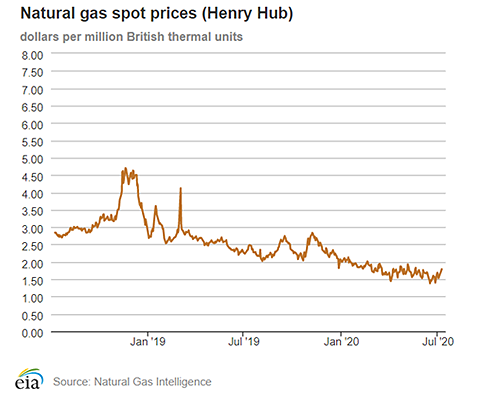
| Spot Prices ($/MMBtu) | Thu, 2-Jul |
Fri, 3-Jul |
Mon, 6-Jul |
Tue, 7-Jul |
Wed, 8-Jul |
|---|---|---|---|---|---|
| Henry Hub | 1.53 | Holiday | 1.70 | 1.74 | 1.79 |
| New York | 1.50 | Holiday | 1.76 | 1.77 | 1.77 |
| Chicago | 1.52 | Holiday | 1.74 | 1.84 | 1.82 |
| Cal. Comp. Avg,* | 1.55 | Holiday | 1.90 | 2.06 | 2.10 |
| Futures ($/MMBtu) | |||||
| July Contract | 1.734 | Holiday | 1.830 | 1.876 | 1.824 |
| August Contract | 1.785 | Holiday | 1.893 | 1.939 | 1.876 |
| *Avg. of NGI's reported prices for: Malin, PG&E Citygate, and Southern California Border Avg. | |||||
| Source: NGI's Daily Gas Price Index | |||||
| Spot Prices ($/MMBtu) | Thu, 25-Jun |
Fri, 26-Jun |
Mon, 29-Jun |
Tue, 30-Jun |
Wed, 1-Jul |
|---|---|---|---|---|---|
| Henry Hub | 1.49 | 1.40 | 1.66 | 1.69 | 1.60 |
| New York | 1.39 | 1.40 | 1.62 | 1.56 | 1.46 |
| Chicago | 1.50 | 1.45 | 1.64 | 1.66 | 1.55 |
| Cal. Comp. Avg,* | 1.81 | 1.66 | 1.81 | 1.77 | 1.66 |
| Futures ($/MMBtu) | |||||
| June Contract | 1.482 | 1.495 | Expired | Expired | Expired |
| July Contract | 1.546 | 1.544 | 1.709 | 1.751 | 1.671 |
| August Contract | 1.612 | 1.605 | 1.754 | 1.789 | 1.721 |
| *Avg. of NGI's reported prices for: Malin, PG&E Citygate, and Southern California Border Avg. | |||||
| Source: NGI's Daily Gas Price Index | |||||
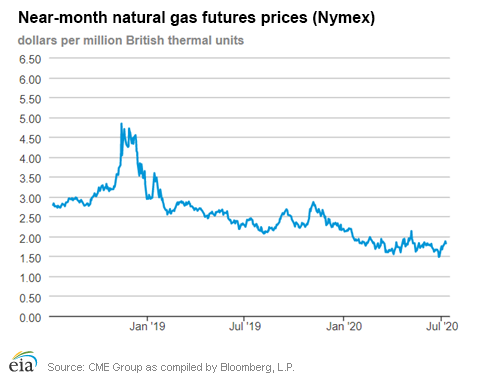
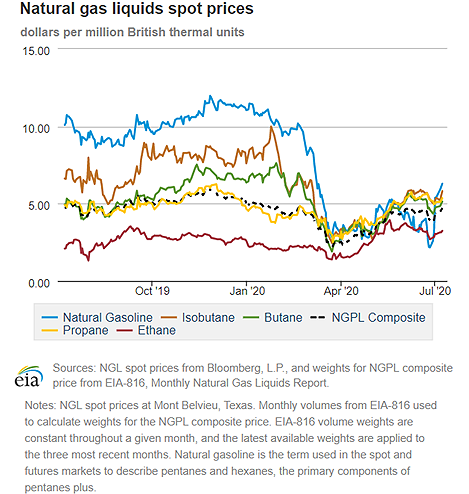
| U.S. natural gas supply - Gas Week: (7/2/20 - 7/8/20) | |||
|---|---|---|---|
Average daily values (Bcf/d): |
|||
this week |
last week |
last year |
|
| Marketed production | 101.3 |
99.7 |
105.0 |
| Dry production | 89.5 |
88.3 |
92.0 |
| Net Canada imports | 4.2 |
4.1 |
5.2 |
| LNG pipeline deliveries | 0.1 |
0.2 |
0.1 |
| Total supply | 93.9 |
92.6 |
97.3 |
|
Source: IHS Markit | |||
| U.S. natural gas consumption - Gas Week: (7/2/20 - 7/8/20) | |||
|---|---|---|---|
Average daily values (Bcf/d): |
|||
this week |
last week |
last year |
|
| U.S. consumption | 69.4 |
66.9 |
68.5 |
| Power | 40.5 |
37.9 |
39.3 |
| Industrial | 20.1 |
20.3 |
21.0 |
| Residential/commercial | 8.7 |
8.7 |
8.1 |
| Mexico exports | 5.3 |
5.6 |
5.4 |
| Pipeline fuel use/losses | 5.5 |
5.4 |
6.5 |
| LNG pipeline receipts | 3.1 |
4.4 |
6.2 |
| Total demand | 83.4 |
82.2 |
86.5 |
|
Source: IHS Markit | |||
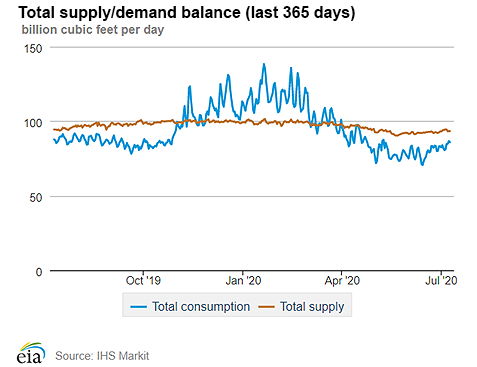
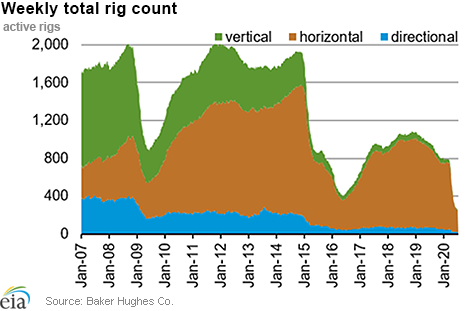
| Rigs | |||
|---|---|---|---|
Tue, June 30, 2020 |
Change from |
||
last week |
last year |
||
| Oil rigs | 185 |
-1.6% |
-76.5% |
| Natural gas rigs | 76 |
1.3% |
-56.3% |
| Note: Excludes any miscellaneous rigs | |||
| Rig numbers by type | |||
|---|---|---|---|
Tue, June 30, 2020 |
Change from |
||
last week |
last year |
||
| Vertical | 17 |
13.3% |
-70.7% |
| Horizontal | 226 |
-1.7% |
-73.1% |
| Directional | 20 |
0.0% |
-69.7% |
| Source: Baker Hughes Co. | |||
| Working gas in underground storage | ||||
|---|---|---|---|---|
Stocks billion cubic feet (Bcf) |
||||
| Region | 2020-07-03 |
2020-06-26 |
change |
|
| East | 657 |
639 |
18 |
|
| Midwest | 761 |
740 |
21 |
|
| Mountain | 180 |
173 |
7 |
|
| Pacific | 310 |
304 |
6 |
|
| South Central | 1,226 |
1,222 |
4 |
|
| Total | 3,133 |
3,077 |
56 |
|
|
Source: Form EIA-912, Weekly Underground Natural Gas Storage Report | ||||
| Working gas in underground storage | |||||
|---|---|---|---|---|---|
Historical comparisons |
|||||
Year ago (7/3/19) |
5-year average (2015-2019) |
||||
| Region | Stocks (Bcf) |
% change |
Stocks (Bcf) |
% change |
|
| East | 539 |
21.9 |
566 |
16.1 |
|
| Midwest | 589 |
29.2 |
623 |
22.2 |
|
| Mountain | 138 |
30.4 |
166 |
8.4 |
|
| Pacific | 261 |
18.8 |
290 |
6.9 |
|
| South Central | 921 |
33.1 |
1,033 |
18.7 |
|
| Total | 2,448 |
28.0 |
2,679 |
16.9 |
|
| Source: Form EIA-912, Weekly Underground Natural Gas Storage Report | |||||
| Temperature – heating & cooling degree days (week ending Jul 02) | ||||||||
|---|---|---|---|---|---|---|---|---|
HDD deviation from: |
CDD deviation from: |
|||||||
| Region | HDD Current |
normal |
last year |
CDD Current |
normal |
last year |
||
| New England | 1 |
-3 |
1 |
38 |
10 |
-13 |
||
| Middle Atlantic | 0 |
-1 |
0 |
62 |
19 |
-8 |
||
| E N Central | 0 |
-2 |
0 |
73 |
27 |
-14 |
||
| W N Central | 0 |
-4 |
0 |
83 |
23 |
-5 |
||
| South Atlantic | 0 |
0 |
0 |
104 |
15 |
-5 |
||
| E S Central | 0 |
0 |
0 |
88 |
3 |
-11 |
||
| W S Central | 0 |
0 |
0 |
129 |
14 |
16 |
||
| Mountain | 9 |
-3 |
7 |
59 |
-10 |
-18 |
||
| Pacific | 5 |
-3 |
1 |
23 |
-11 |
-2 |
||
| United States | 2 |
-2 |
1 |
75 |
11 |
-5 |
||
|
Note: HDD = heating degree day; CDD = cooling degree day Source: National Oceanic and Atmospheric Administration | ||||||||
Average temperature (°F)
7-day mean ending Jul 02, 2020
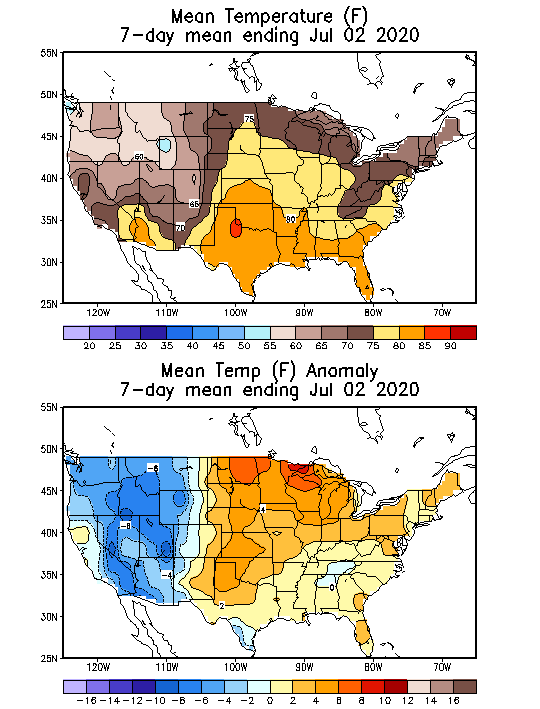
Source: National Oceanic and Atmospheric Administration
Deviation between average and normal (°F)
7-day mean ending Jul 02, 2020

Source: National Oceanic and Atmospheric Administration

